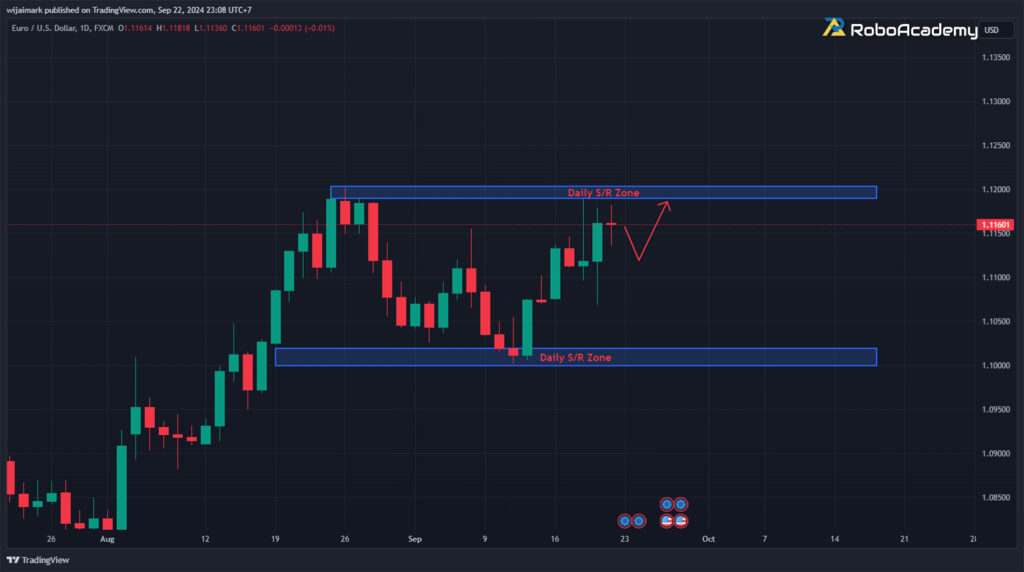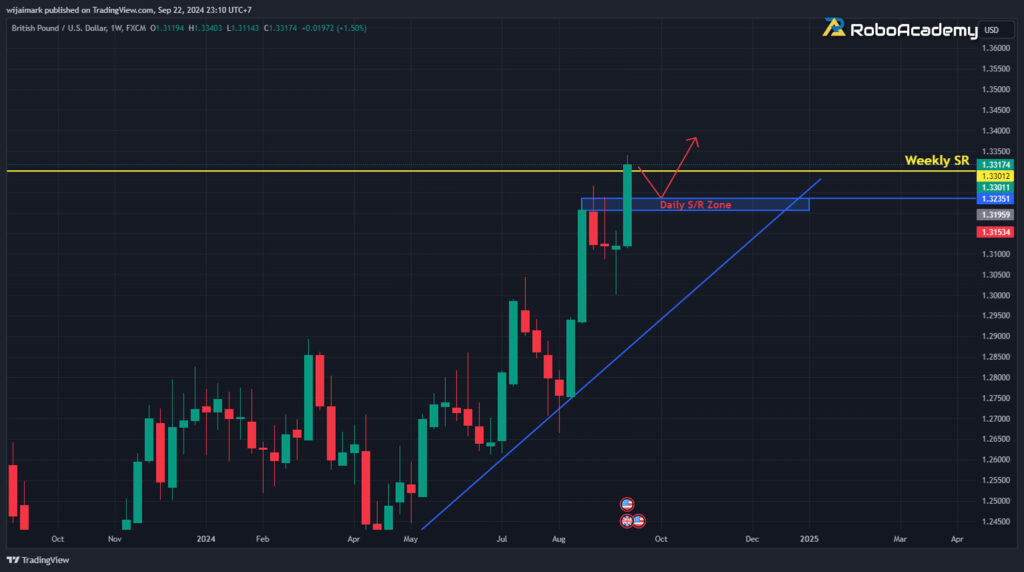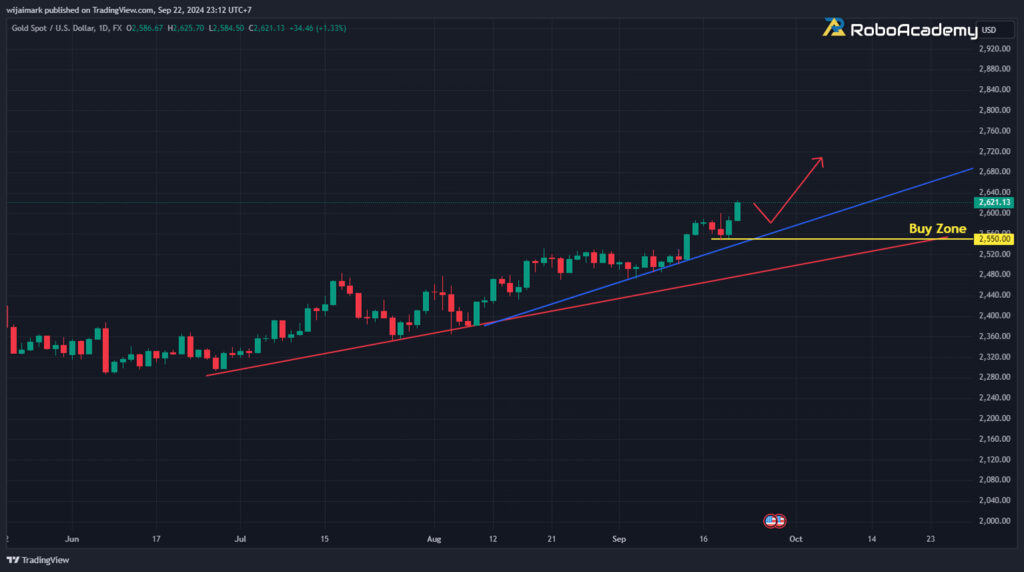Fundamental & Technical Analysis by Coach Mark RoboAcademy during 23 – 27 September 2024
Hello everyone, welcome to the weekly analysis of currency pairs EUR/USD, GBP/USD, and XAU/USD for the fourth week of September, from 23 – 27 September 2024.
EUR/USD, “Euro vs US Dollar”

Fundamental Analysis
Significant Economic Events Impacting EUR/USD This Week:
European Economic Data:
- Monetary Policy of the ECB: Statements or speeches from officials of the European Central Bank (ECB) may indicate potential adjustments to future monetary policy. The inflation trend in the Eurozone remains a key driver for changes in interest rates.
- Eurozone PMI: The release of the Purchasing Managers’ Index (PMI) data for the manufacturing and services sectors provides an overview of economic activity. If the figures are strong, the Euro may strengthen, while weak data could lead to a depreciation of the Euro.
- IFO Business Climate Index: Germany’s IFO Index, an indicator of economic confidence, offers insights into the business environment in the Eurozone’s largest economy. Strong data may support the Euro, while poor results could signal economic challenges.
U.S. Economic Data:
- Federal Reserve Statements: Any communication from the Fed regarding monetary policy will impact the U.S. dollar. If inflationary pressures persist, the Fed may maintain a hawkish stance, supporting a stronger dollar.
- U.S. GDP: The second-quarter GDP figures (final estimate) release will be a key factor. If the revised estimates surpass expectations, it could lead to a stronger U.S. dollar.
- Core Personal Consumption Expenditures (Core PCE) Index: This index is a key inflation measure closely watched by the Fed. If inflation remains high, it could result in the appreciation of the U.S. dollar.
Technical Analysis
The current price is testing the upper resistance zone around 1.12000. A potential strategy is to use the “Buy on dip” technique—buying if the price retraces, anticipating a breakout above the resistance. However, caution is needed, as there is also a support zone around 1.10000, where the price could pull back sharply. It’s crucial to observe the price action and other factors during the upcoming trading week. If news supports a stronger USD, the price could experience a significant downward move.
GBP/USD, “Great Britain Pound vs US Dollar”

Fundamental Analysis
Significant Economic Events Impacting GBP/USD This Week:
U.K. Economic Data:
- Monetary Policy of BoE: Statements from BoE officials may provide clues about interest rate trends. Rate hikes or cuts will depend on inflation and economic growth in the UK, influencing the pound’s value.
- UK PMI: The release of manufacturing and services PMI figures will indicate economic activity. Strong numbers could support the pound, while weaker figures may lead to a depreciation of the currency.
- UK Government Financial Reports: The disclosure of government financial data, including budget deficits, will impact the economic outlook and the pound’s direction. Strict budget control or increased investment in infrastructure could help bolster the pound.
U.S. Economic Data:
- Federal Reserve Statements: The Fed’s stance on controlling inflation and interest rates will impact the U.S. dollar. A more hawkish stance from the Fed could strengthen the dollar, leading to a decline in GBP/USD.
- U.S. GDP: The announcement of the U.S. second-quarter GDP figures will be a key factor. If the growth surpasses expectations, the dollar may gain support, causing the pound to weaken.
- Core Personal Consumption Expenditures (Core PCE) Index: This is a key inflation gauge for the Fed. If inflation remains elevated, it could result in a stronger U.S. dollar.
Technical Analysis
The recent price action confirmed a Break of Structure by closing above the old weekly resistance, indicating the potential for further upward movement, making a Buy position favorable. However, similar to EURUSD, there may be a pullback to a minor support zone around 1.32300. It’s recommended to wait for this retracement before entering a Buy position.
XAU/USD, “Gold vs US Dollar”

Fundamental Analysis
Significant Economic Events Impacting XAU/USD This Week:
Economic Data Related to Gold:
- U.S. Monetary Policy: If the Fed signals continued interest rate hikes to combat inflation, the U.S. dollar may strengthen, leading to a decline in gold (XAU) prices. As a non-yielding asset, higher interest rates make gold less attractive.
- Core Personal Consumption Expenditures (Core PCE) Index: If inflation remains high, the Fed may maintain a hawkish stance, strengthening the dollar and putting pressure on gold prices.
- U.S. GDP: Strong U.S. GDP figures could boost the dollar and lead to a decrease in gold prices, as investors shift towards higher-yielding assets.
- U.S. Inflation Data: If high inflation raises expectations for tighter monetary policy, gold may face pressure, as it typically moves inversely to the dollar.
Technical Analysis
The current gold price is in the ATH zone, and ongoing economic factors support further upward movement. A Buy-on-dip strategy is recommended, but caution is advised due to the possibility of sharp reversals. Keeping an eye on this week’s news, which may cause significant volatility, is essential. A potential Buy zone is identified around 2600.
Disclaimer: This article is solely an analysis from the coach at RoboAcademy and is not intended as investment advice in any way. Investing is risky. Investors should study the information before making investment decisions.


